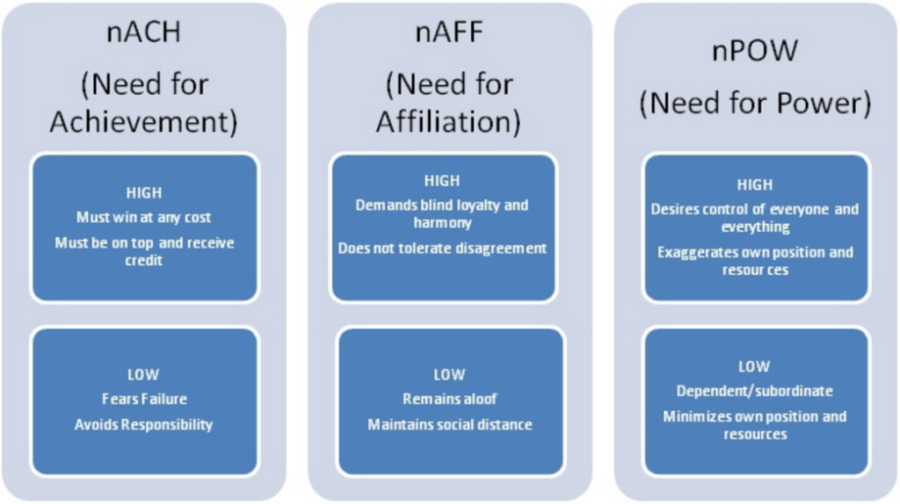In today’s organizations, people work in teams that have either a leader or a self-driven team member to lead. While these teams provide support mechanism in the office environment and are used to improve productivity and results, they are also a source of competition. It is this team building scenario that is envisioned to promote the productivity of the employees, and at the same time the organization. In any team there is a difference of opinions, this is beneficial as it provides the building blocks to ideas for their team and organization as a whole. At the same time these opinions do raise the emotions and feelings of the team players. There arises conflict within the group that either improves the team’s performance or the breaks down of the team and consequently hampering the achievement of the organizations goal. The most common team problems are; Floundering: This problem occurs in Continue reading
HRM Concepts
Theories of Motivation: McClelland’s Three Need Model
Each person tends to develop certain motivational drives as a result of his cognitive pattern and the environment in which he lives. David McClelland gave a model of motivation, which is based on three types of needs, namely, achievement, power and affiliation. They are stated below: Need for achievement (n-Ach): a drive to excel, advance and grow; Need for power (n-Pow): a drive to influence others and situations; and Need for affiliation (n-Aff): a drive for friendly and close interpersonal relationships. Achievement motivation: some people have a compelling drive to succeed and they strive for personal achievement rather than the rewards of success that accompany it. They have a desire to do something better or more efficiently than it has been done before. This drive is the achievement need. From researches into the area of achievement need, McClelland found that high achievers differentiate themselves from others by their desire to Continue reading
Morale and Productivity
The satisfaction and comfort an employee experiences at the workplace is termed morale. Morale is a widely used term in organizations. But in general, it refers to esprit de corps, a feeling of enthusiasm, zeal, confidence in individuals or groups that they will be able to cope with the tasks assigned to them. The result of high morale generally results in the high efficiency of the organization. Morale directly impacts the working of an individual in a team towards the realization of common objectives. Morale therefore is individual specific as well as general. Unfortunately building of morale is not a mechanical problem that could be solved by either rewards or punishments. The best way to manage it is to proactively do a lot of employee related interventions that will together impact morale positively. Morale can also be understood as the spirit and confidence with which the employee performs his job. Continue reading
Ranking Method of Job Evaluation
Ranking Method is the simplest form of job evaluation method. The method involves ranking each job relative to all other jobs, usually based on some overall factor like ‘job difficulty’. Each job as a whole is compared with other and this comparison of jobs goes on until all the jobs have been evaluated and ranked. All jobs are ranked in the order of their importance from the simplest to the hardest or from the highest the lowest. The importance of order of job is judged in terms of duties, responsibilities sand demands on the job holder. The following steps are involved in ranking jobs. Obtain job information – The first step of ranking method of job evaluation is the job analysis. Job descriptions for each job are prepared and these are the basis on which the rankings are made. The job ranking method usually ranks jobs according to ‘the whole Continue reading
Nepotism in the Workplace
Nepotism can be defined as the practice of making employment decisions on the basis of relationship. It can also be defined as hiring or promoting a relative or friend, even if there are other qualified candidates for the position. Nepotism at work refers to favoring relatives in employment or economic terms as opposed to them being judged on ability and/or merit in a specific organisation. This could include a position over somebody else who may be more suitable for the position, whereby the organization would be paying a relative more money than somebody doing the same job or granting them special favors. However, nepotism can be viewed in terms of people giving somebody a boost up to allow them to get into an organisation but will be treated in the same manner as everybody else. Although nepotism is in the sense of the word, refers to relatives, it can also Continue reading
Human Resources as a Strategic Partner in an Organization
The general scenario in most companies is as follows. HR management teams have well-developed visions of their departments, their roles and responsibilities. But, the senior management is generally skeptical of HR’s role in the firm’s success. They generally consider HR to just be another necessary appendage but not something that can contribute to the success of the company. Even if the senior management does believe that human capital is their most prized possession and asset, they cannot understand how the HR team can make this belief come alive. There is one reason for all of this. Human capital is an intangible asset and HR’s influence on firm performance is difficult to measure. The standard elements of a firm’s resource architecture that are measured include total compensation, employee turnover, cost per hire, percentage of employees that undergo performance appraisals and percentage employee satisfaction. The question to be asked is: Are these Continue reading


